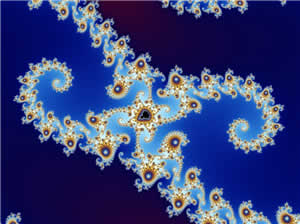Imaginary Numbers
An imaginary number, when squared, gives a negative result.
Let's try squaring some numbers to see if we can get a negative result:
- 2 × 2 = 4
- (−2) × (−2) = 4 (because a negative times a negative gives a positive)
- 0 × 0 = 0
- 0.1 × 0.1 = 0.01
No luck! Always positive, or zero.
It seems we cannot multiply a number by itself to get a negative answer ...

... but imagine there is such a number (call it i for imaginary) that can do this:
Would it be useful, and what could we do with it?
We start by defining the number i to be the square root of −1:
This lets us work with square roots of negative numbers in a consistent way.
Which is actually very useful because ...
... by simply accepting that i exists we can solve things
that need the square root of a negative number.
Can you take the square root of −1?
Well i can!
Let us have a go:
Example: Solve x2 + 9 = 0
We can solve it step by step:
Because we define i as √−1 we can now do this:
So imaginary numbers help us solve equations that real numbers alone can't.
Also notice that the square root of −9 is simply the square root of +9 (=3) times i.
This rule works for any positive number x:
√(−x) = i√x
So long as we keep that little "i" there to remind us that we still
need to multiply by √−1 we are safe to continue with our solution!
From Imaginary to Real
Example: What is (5i)2 ?
Interesting! We used an imaginary number (5i) and ended up with a real solution (−25).
Unit Imaginary Number

The square root of minus one √(−1) is the "unit" imaginary number, the equivalent of 1 for Real Numbers.
In mathematics the symbol for √(−1) is i for imaginary.
But in electronics the symbol is j, because i is used for current, and j is next in the alphabet.
Examples of Imaginary Numbers
| i | 12.38i | −i | 3i/4 | 0.01i | πi |
Imaginary Numbers are not "Imaginary"
Imaginary numbers were once thought to be impossible, and so they were called "imaginary " (to make fun of them).
But then people researched them more and discovered they were actually useful and important because they filled a gap in mathematics ... but the imaginary name has stuck.
And that's also how the name Real Numbers became popular (real is not imaginary).
Imaginary Numbers are Useful
Imaginary numbers were first introduced by mathematicians in the 16th century to solve equations that seemed impossible. Today, they’re used in everything from designing airplanes to creating special effects in movies.
Complex Numbers

Imaginary numbers become most useful when combined with real numbers to make complex numbers like 3+5i or 6−4i
Spectrum Analyzer

Those cool displays you see when music is playing? Yep, Complex Numbers are used to calculate them! Using something called "Fourier Transforms".
In fact many clever things can be done with sound using Complex Numbers, like filtering out sounds, hearing whispers in a crowd and so on.
It is part of a subject called "Signal Processing".
Electricity


AC (Alternating Current) Electricity changes between positive and negative in a sine wave.
When we combine two AC currents they may not match properly, and it can be very hard to figure out the new current.
But using complex numbers makes it a lot easier to do the calculations.
And the result may have "imaginary " current, but it can still hurt you!
Mandelbrot Set

The beautiful Mandelbrot Set (part of it is pictured here) is created using Complex Numbers.
Quadratic Equation
The Quadratic Equation, which has many uses,
can give results that include imaginary numbers
Also Science, Quantum mechanics and Relativity use complex numbers.
Interesting Property
The Unit imaginary number, i, has an interesting property. It "cycles" through 4 different values each time we multiply:
|
|||||||||||||||||
So we have this:
| i = √−1 | i2 = −1 | i3 = −√−1 | i4 = +1 |
| i5 = √−1 | i6 = −1 | ...and so on |
Example What is i10 ?
And that leads us into another topic, the complex plane:
In Summary
- Imaginary numbers are based on √−1, which we call i
- They help us solve equations real numbers can’t
- They’re used in engineering, physics, and art
- When combined with real numbers, they form complex numbers